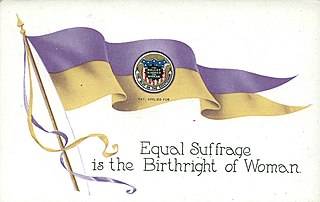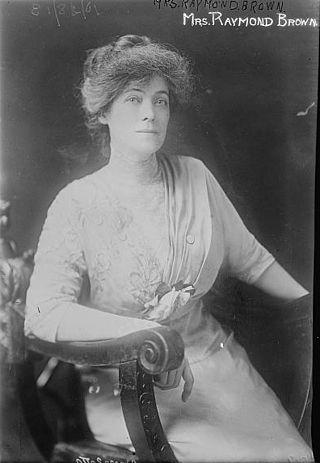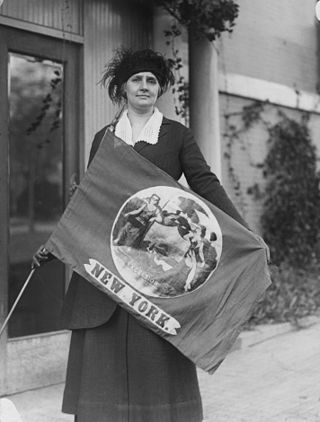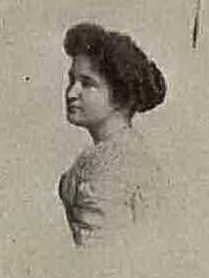Mary Edith Campbell | |
|---|---|
 | |
| Born | 1876 |
| Died | 1962 (aged 85–86) |
| Nationality | American |
| Occupation(s) | Politician, Activist |

Mary Edith Campbell sometimes known as Edith Campbell, was an American suffragist and social economist.
Mary Edith Campbell | |
|---|---|
 | |
| Born | 1876 |
| Died | 1962 (aged 85–86) |
| Nationality | American |
| Occupation(s) | Politician, Activist |

Mary Edith Campbell sometimes known as Edith Campbell, was an American suffragist and social economist.
Campbell was born on December 27, [1] 1875 or 1876. [2] In 1911 she was the first woman elected to the Board of Education in Cincinnati, Ohio with an endorsement from U.S. President William Howard Taft. [3] [4] In 1931 she was given an honorary degree. [5]
Campbell was the first president of the Woman's City Club of Greater Cincinnati, She was a member of the Juvenile Protective Association and the Cincinnati League of Women Voters. [2]
Campbell died in 1962, leaving her estate to Planned Parenthood of Cincinnati [2]

The National American Woman Suffrage Association (NAWSA) was an organization formed on February 18, 1890, to advocate in favor of women's suffrage in the United States. It was created by the merger of two existing organizations, the National Woman Suffrage Association (NWSA) and the American Woman Suffrage Association (AWSA). Its membership, which was about seven thousand at the time it was formed, eventually increased to two million, making it the largest voluntary organization in the nation. It played a pivotal role in the passing of the Nineteenth Amendment to the United States Constitution, which in 1920 guaranteed women's right to vote.

Carrie Chapman Catt was an American women's suffrage leader who campaigned for the Nineteenth Amendment to the United States Constitution, which gave U.S. women the right to vote in 1920. Catt served as president of the National American Woman Suffrage Association from 1900 to 1904 and 1915 to 1920. She founded the League of Women Voters in 1920 and the International Woman Suffrage Alliance in 1904, which was later named International Alliance of Women. She "led an army of voteless women in 1919 to pressure Congress to pass the constitutional amendment giving them the right to vote and convinced state legislatures to ratify it in 1920". She "was one of the best-known women in the United States in the first half of the twentieth century and was on all lists of famous American women."

Women's suffrage, or the right of women to vote, was established in the United States over the course of the late 19th and early 20th centuries, first in various states and localities, then nationally in 1920 with the ratification of the 19th Amendment to the United States Constitution.

Kate Langley Bosher was an American novelist from Virginia, best known for her novels Mary Cary (1910) and Miss Gibbie Gault (1911). She was also a suffragist and founding member and officer of the Equal Suffrage League of Virginia.

The College Equal Suffrage League (CESL) was an American woman suffrage organization founded in 1900 by Maud Wood Park and Inez Haynes Irwin, as a way to attract younger Americans to the women's rights movement. The League spurred the creation of college branches around the country and influenced the actions of other prominent groups such as National American Woman Suffrage Association (NAWSA).

Women's suffrage was established in the United States on a full or partial basis by various towns, counties, states, and territories during the latter decades of the 19th century and early part of the 20th century. As women received the right to vote in some places, they began running for public office and gaining positions as school board members, county clerks, state legislators, judges, and, in the case of Jeannette Rankin, as a member of Congress.

Ida Sedgwick Proper was an American suffragist, writer and artist. She was an art editor for The Woman Voter. Proper has work in the permanent collections of the Smithsonian, and the Des Moines Art Center.

The Dallas Equal Suffrage Association (DESA) was an organization formed in Dallas, Texas in 1913 to support the cause of women's suffrage in Texas. DESA was different from many other suffrage organizations in the United States in that it adopted a campaign which matched the social expectations of Dallas at the time. Members of DESA were very aware of the risk of having women's suffrage "dismissed as 'unladylike' and generally disreputable." DESA "took care to project an appropriate public image." Many members used their status as mothers in order to tie together the ideas of motherhood and suffrage in the minds of voters. The second president of DESA, Erwin Armstrong, also affirmed that women were not trying to be unfeminine, stating at an address at a 1914 Suffrage convention that "women are in no way trying to usurp the powers of men, or by any means striving to wrench from man the divine right to rule." The organization also helped smaller, nearby towns to create their own suffrage campaigns. DESA was primarily committed to securing the vote for white women, deliberately ignoring African American women in the process. Their defense of ignoring black voters was justified by having a policy of working towards "only one social reform at a time."

Gertrude Foster Brown was a concert pianist, teacher, and suffragist. Following the passage of women suffrage in New York State in 1917, and pending passage of the Nineteenth Amendment to the United States Constitution, Brown wrote Your Vote and How to Use It, published in 1918. She was Director-General of the Women's Overseas Hospitals in France, founded by suffragists, in 1918. In addition to her work in the New York suffrage movement, she helped to found the National League of Women Voters. She was the Managing Director of the Woman's Journal from 1921-1931.

Edith M. Ainge (1873–1948) was an American suffragist and a member of the activist group the Silent Sentinels. Ainge joined the National Woman's Party (NWP) led by Alice Paul to advocate for women's right to vote in the United States, which was established with the ratification of the 19th amendment in 1920. Ainge was arrested approximately five times from September 1917 to January 1919 for "unlawful assembly" at NWP protests, and she later served as treasurer of the NWP.
This timeline provides an overview of the political movement for women's suffrage in California. Women's suffrage became legal with the passage of Proposition 4 in 1911 yet not all women were enfranchised as a result of this legislation.

The women's suffrage movement began in California in the 19th century and was successful with the passage of Proposition 4 on October 10, 1911. Many of the women and men involved in this movement remained politically active in the national suffrage movement with organizations such as the National American Women's Suffrage Association and the National Woman's Party.

Women's rights issues in Ohio were put into the public eye in the early 1850s. Women inspired by the Declaration of Rights and Sentiments at the 1848 Seneca Falls Convention created newspapers and then set up their own conventions, including the 1850 Ohio Women's Rights Convention which was the first women's right's convention outside of New York and the first that was planned and run solely by women. These early efforts towards women's suffrage affected people in other states and helped energize the women's suffrage movement in Ohio. Women's rights groups formed throughout the state, with the Ohio Women's Rights Association (OWRA) founded in 1853. Other local women's suffrage groups are formed in the late 1860s. In 1894, women won the right to vote in school board elections in Ohio. The National American Woman Suffrage Association (NAWSA) was headquartered for a time in Warren, Ohio. Two efforts to vote on a constitutional amendment, one in 1912 and the other 1914 were unsuccessful, but drew national attention to women's suffrage. In 1916, women in East Cleveland gained the right to vote in municipal elections. A year later, women in Lakewood, Ohio and Columbus were given the right to vote in municipal elections. Also in 1917, the Reynolds Bill, which would allow women to vote in the next presidential election was passed, and then quickly repealed by a voter referendum sponsored by special-interest groups. On June 16, 1919, Ohio became the fifth state to ratify the Nineteenth Amendment.

Women's suffrage began in Nevada began in the late 1860s. Lecturer and suffragist Laura de Force Gordon started giving women's suffrage speeches in the state starting in 1867. In 1869, Assemblyman Curtis J. Hillyer introduced a women's suffrage resolution in the Nevada Legislature. He also spoke out on women's rights. Hillyer's resolution passed, but like all proposed amendments to the state constitution, must pass one more time and then go out to a voter referendum. In 1870, Nevada held its first women's suffrage convention in Battle Mountain Station. In the late 1880s, women gained the right to run for school offices and the next year several women are elected to office. A few suffrage associations were formed in the mid 1890s, with a state group operating a few women's suffrage conventions. However, after 1899, most suffrage work slowed down or stopped altogether. In 1911, the Nevada Equal Franchise Society (NEFS) was formed. Attorney Felice Cohn wrote a women's suffrage resolution that was accepted and passed the Nevada Legislature. The resolution passed again in 1913 and will go out to the voters on November 3, 1914. Suffragists in the state organized heavily for the 1914 vote. Anne Henrietta Martin brought in suffragists and trade unionists from other states to help campaign. Martin and Mabel Vernon traveled around the state in a rented Ford Model T, covering thousands of miles. Suffragists in Nevada visited mining towns and even went down into mines to talk to voters. On November 3, the voters of Nevada voted overwhelmingly for women's suffrage. Even though Nevada women won the vote, they did not stop campaigning for women's suffrage. Nevada suffragists aided other states' campaigns and worked towards securing a federal suffrage amendment. On February 7, 1920, Nevada became the 28th state to ratify the Nineteenth Amendment.

The first women's suffrage effort in Florida was led by Ella C. Chamberlain in the early 1890s. Chamberlain began writing a women's suffrage news column, started a mixed-gender women's suffrage group and organized conventions in Florida.

Kathryn Helene Starbuck was an American lawyer, suffragette, and law professor from New York.

Mary Inez Wood was an American writer and leader in women's rights during the 20th century. She served in various important positions, such as the first president of the New Hampshire League of Women Voters and the Manager of Bureau of Information for the General Federation of Women's Clubs. Additionally, she was the author of the History of the General Federation of Women's Clubs. Wood was described as "one of the most loved and respected women of New Hampshire" according to the Woman Citizen.
In this stamping ground of conservative men and women it was found that the voters had given Miss Edith Campbell enough votes to qualify her for member of ...
Edith Campbell of this city enjoys the distinction of winning for the woman suffrage cause the highest recognition it has received in this part of the country by the personal endorsement and vote of President Taft for herself as candidate for a member of the Board of Education of Cincinnati. The President scratched his otherwise straight Republican ballot to vote for her.